Territoriality, female care and busy chirps
The multi-faceted breeding biology of the Kloof Frog
Text and photographs Jeanne Tarrant or as credited
The Kloof Frog, Natalobatrachus bonebergi, has a unique breeding biology and parental care strategy – part of what makes this an ‘EDGE’ species; Evolutionarily Distinct and Globally Endangered. Genetically, it is monotypic, meaning it is the only species in its genus. It is restricted to forest patches ranging from Dwesa in the Eastern Cape to south-central Zululand in KwaZulu-Natal. The species has expanded T-shaped toe tips that allow the frogs to move expertly along slippery rocks, branches and leaves that overhang slow-flowing sections of streams to lay their distinct egg clumps, from which hatching tadpoles drop to complete their development. These egg clumps can be anything from 10cm to an astounding 4m above water. Despite many urban threats, the species has an extensive, but fragmented, population in the Upper Highway area, where it persists along stream habitat in remaining naturally forested areas.
The species has been the subject of increased research attention in recent years, including a genetics study through University of KwaZulu-Natal showing that the species comprises two distinct clades – on in the Eastern Cape and southern KwaZulu-Natal, and the second lineage from central KwaZulu-Natal (in Press). An MSc study by Arno van Niekerk through North-West University published in the African Journal of Ecology made never-before recorded observations on visual communication, male–male aggression, parental care and predation, as well as on the acoustics of the call of the Kloof Frog, previously described as ‘inconspicuous’. The results have been fascinating.
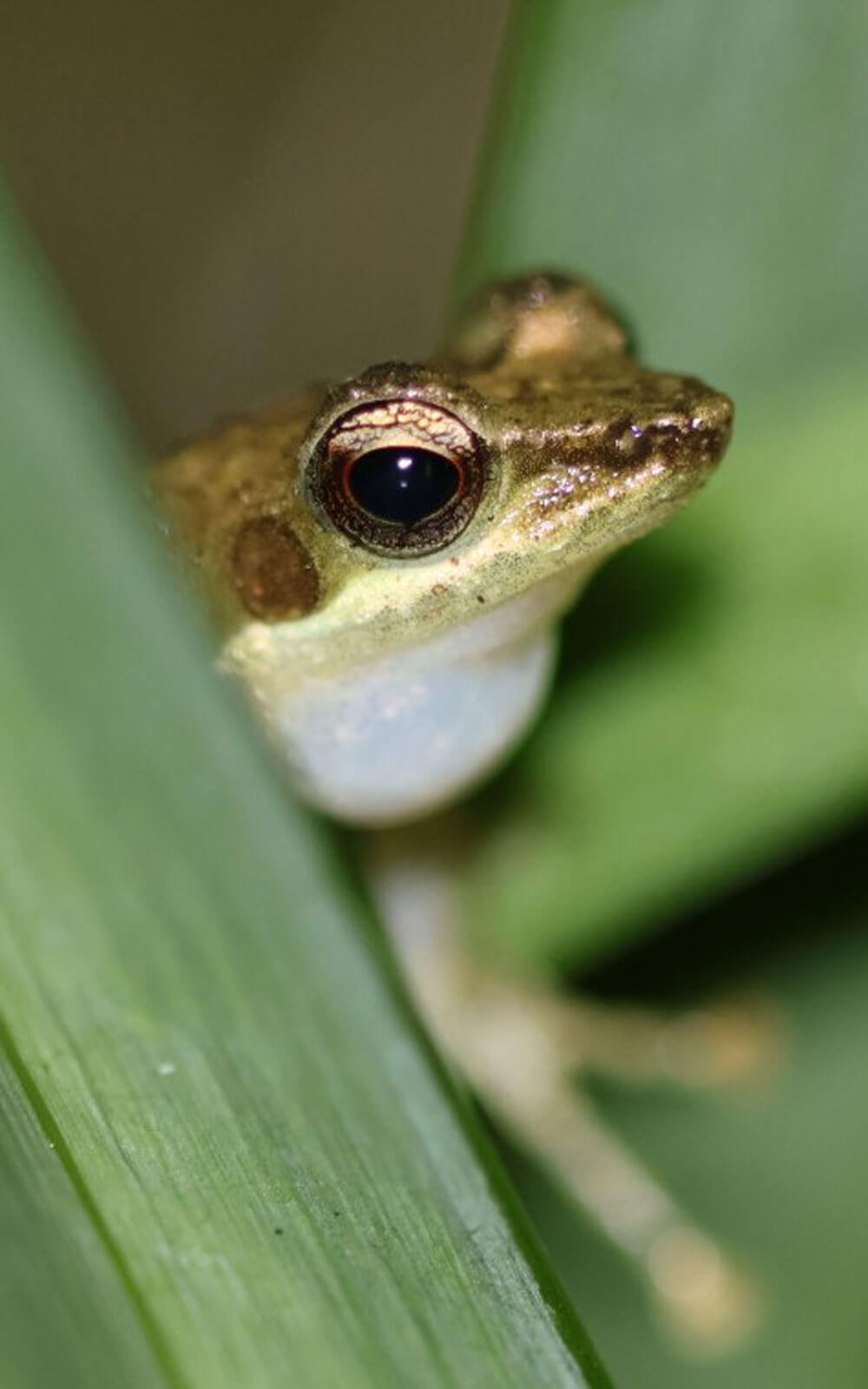
Kloof Frog male calling
The species has complex behavioural and reproductive mechanisms crucial to survive in the highly structured and sheltered habitat it occurs in. The species has an extended breeding season between September to May, where breeding occurs throughout the rainy months. But behind the scenes, there is a lot that happens before females lay their eggs on secure attachment surfaces that are in just the right place to ensure survival of tadpoles.
First, males engage in a full range of fierce competitive behaviours ((brawling, chasing, bumping, pushing, leg kicking and topping) and have an extensive acoustic repertoire, comprising multiple calls and patterns. Males with established territories become highly defensive during the breeding season, enforcing boundaries with great vigour against intruding males. Defending males use an array of acoustic and visual signals in these close-range interactions. Defensive call combinations include clicks, trills, croaks and squeaks associated with visual and physical behaviours. These behaviours include climbing on top of intruders (topping) while calling, toe trembling, physical contact, and sometimes, vocal sac bulging to intimidate and ward off intruders. Toe trembling is employed directly before several agonistic, defensive or reproductive behaviours. Males occasionally tremble their toes in-between calling when defending their territories, but mostly in agonistic interactions. When none of these combinations are successful in deterring intruder males from an established territory, the defending male resorts to kicking and brawling. Defending males position themselves in front of intruders, orienting their bodies away from the intruder and lining themselves up for powerful kicks. With great accuracy, defender males kick at the face of intruders, usually sending intruding males flying from the calling sites. When kicking does not remove or deter intruders, explosive brawling ensues with a cacophony of high-pitch squeaks, kicks and tumbles until one or both males fall from the elevated calling territory. The prevailing male will then be approached by a gravid female when she is ready to lay her eggs. A male and female pair will remain in amplexus at a suitable breeding site for anything between 30 mins and six hours, usually at night. Egg laying itself takes about 10 minutes.
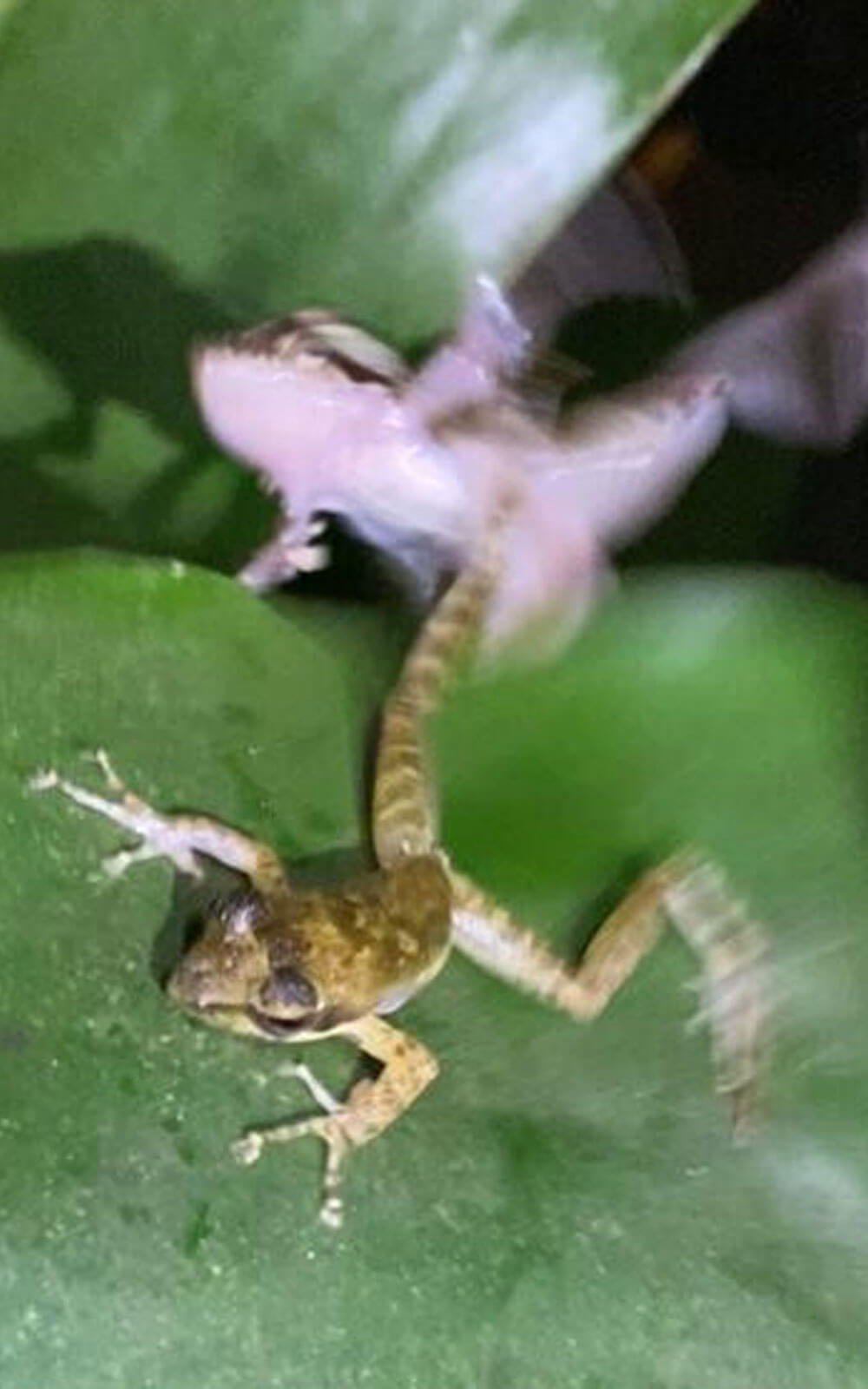
The competition is tough: kickboxing Kloof Frog
Photo: Arno van Niekerk
Directly prior to the female contracting her abdomen to release eggs, both male and female tremble their toes. Females then rub their legs, particularly their thighs, over the egg clump. Males disengage from amplexus and move away once all eggs are laid. The females stay and continuously rub their legs and thighs over their eggs. When males attempt amplexus with females that are tending to eggs, the females will tilt their heads back to push males from their back, or the females may contort their abdomens to loosen the grip of the male’s forelegs. In other instances that have been recorded on video camera, unreceptive females will accurately kick males away when unwanted amplexus is attempted, and in some cases have even been observed ‘poking’ males in the eyes to prevent unwanted attention!
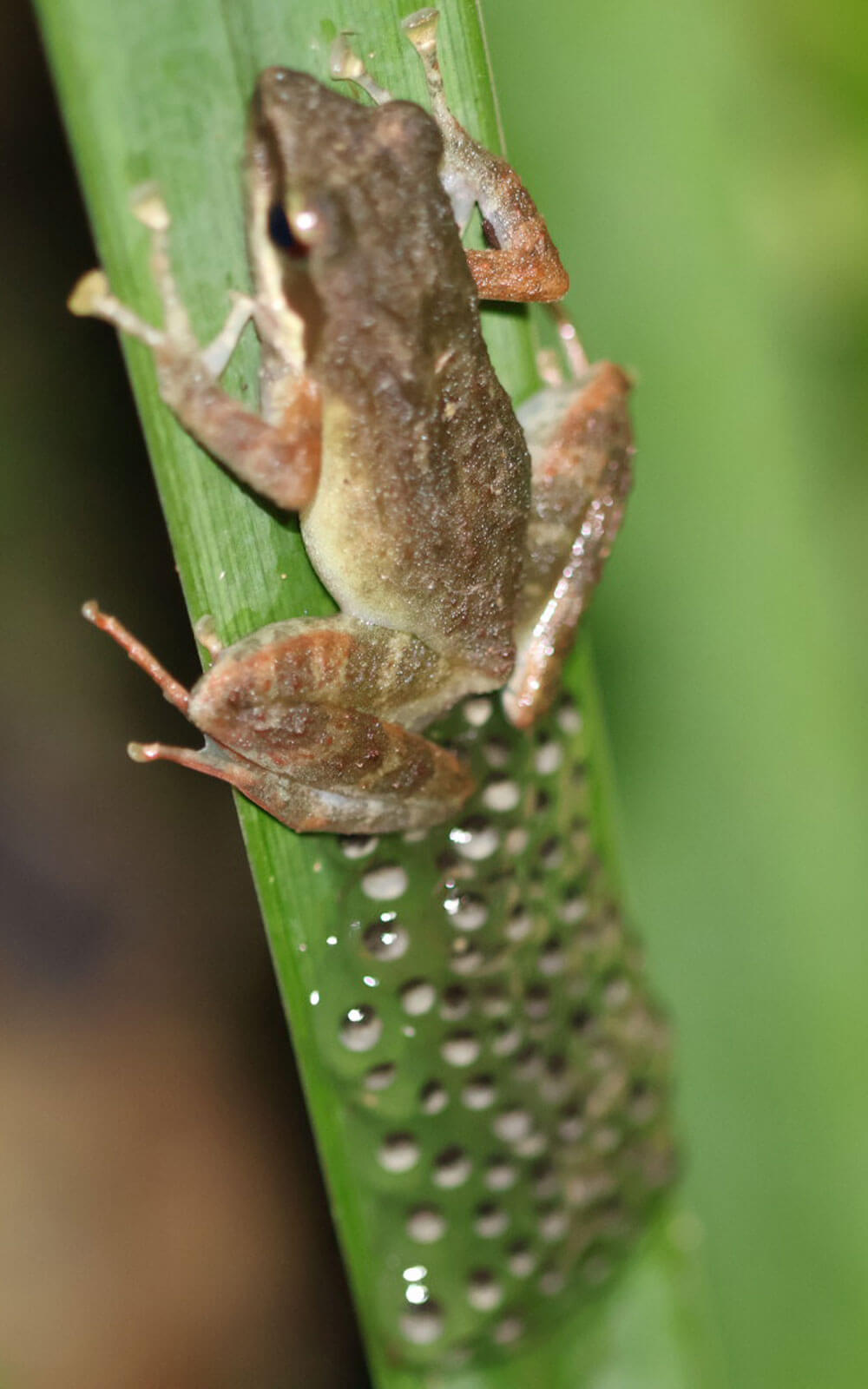
Female Kloof Frog laying eggs
Females express high levels of parental care for their egg clumps up until the late developmental phase of the tadpoles inside the eggs. After absorbing water in the stream, females return to individual egg clutches, depositing the liquid from their swollen bladder in incremental amounts onto eggs while dispersing liquid all over the eggs with their legs. Females grip the egg-attachment surface (usually a leaf) firmly with their hands while rubbing the liquid thoroughly over the egg clump using their hindlegs and feet. Females regularly visit and moisten their egg clutches soon after laying, with the frequency of visits being highest during the early phases of embryological development.
This research has shown that the Kloof Frog is not limited to one mode of communication (i.e., acoustic communication), but rather possesses a complex repertoire of acoustic and visual signals which are used simultaneously or sequentially in interactions between individuals. Through this work, a range of previously unknown call types have also been recorded throughout the breeding season, most of which are used during antagonistic interactions between males.
To build on this observational work, another study by the Endangered Wildlife Trust published in the African Journal of Herpetology, made use of camera traps to understand more about the behaviour of Kloof frogs. The use of camera traps for amphibian research is relatively minimal, with less than 2% of camera trap studies involving amphibians globally. This is in part because frogs are too small to trigger the camera sensor, and more broadly because amphibians are generally under-studied and under-funded, with most research of this kind focussed on the charismatic megafauna. However, given that so little is known about most frog species, and that they do indeed have fascinating life-histories, this technology may offer new insights into anuran behaviour. With kind sponsorship from Camera Traps CC, based locally in Winston Park, this study made use of images taken on time lapse to elucidate behaviour of the Kloof Frog at Vernon Crookes Nature Reserve on the south coast.
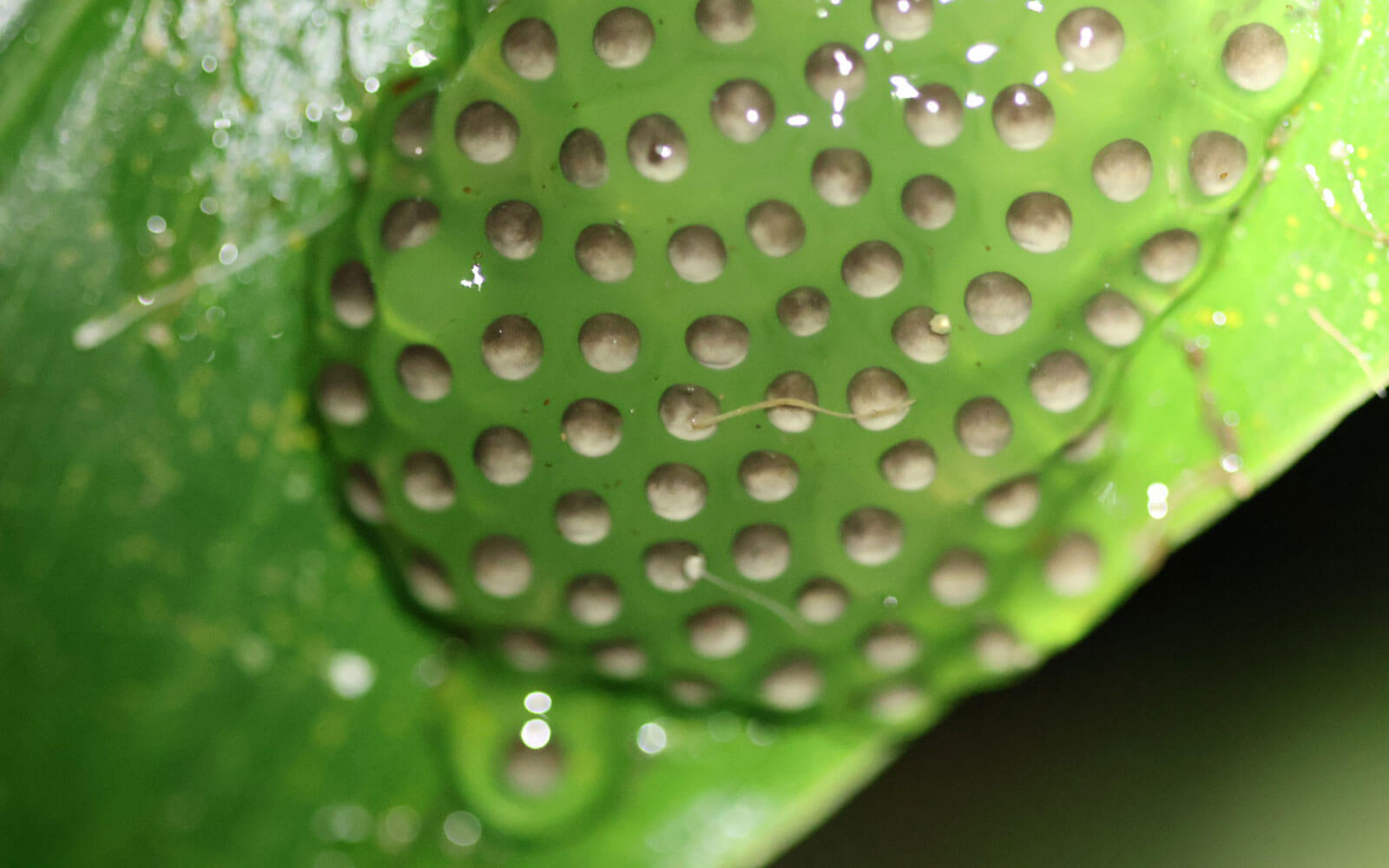
Kloof Frog eggs
Over 40,000 images were taken across a 96-day period between January and December 2021, using one minute time lapse intervals from 18h00 to 06h00. The insights gained from these observations of the Kloof Frog confirmed that the species selects preferred egg-laying sites and that breeding behaviour tends to follow a specific pattern, with amplectant pairs appearing to inspect the laying site prior to the female depositing eggs. These insights into the behaviour of the Kloof Frog provide an improved understanding of the species’ unique biology, as well as the factors that influence breeding success. Particularly in KwaZulu-Natal, populations of the Kloof Frog are threatened by removal of vegetation, pollution and sedimentation entering streams. The species is a habitat specialist, so changes to important variables such as temperature, level of shade and availability of egg-attachment plants, could all significantly impact breeding success. Climate change could therefore pose a major threat to this species and ensuring that populations have resilience through improved conservation management will be critical to ensuring survival, especially in urban areas. Maintaining the integrity of riparian vegetation should be a conservation management priority for sites at which this species occurs. Similarly, because females absorb water from streams to keep egg clumps moist, it is essential that water quality is good because polluted water could negatively impact the development of the eggs.
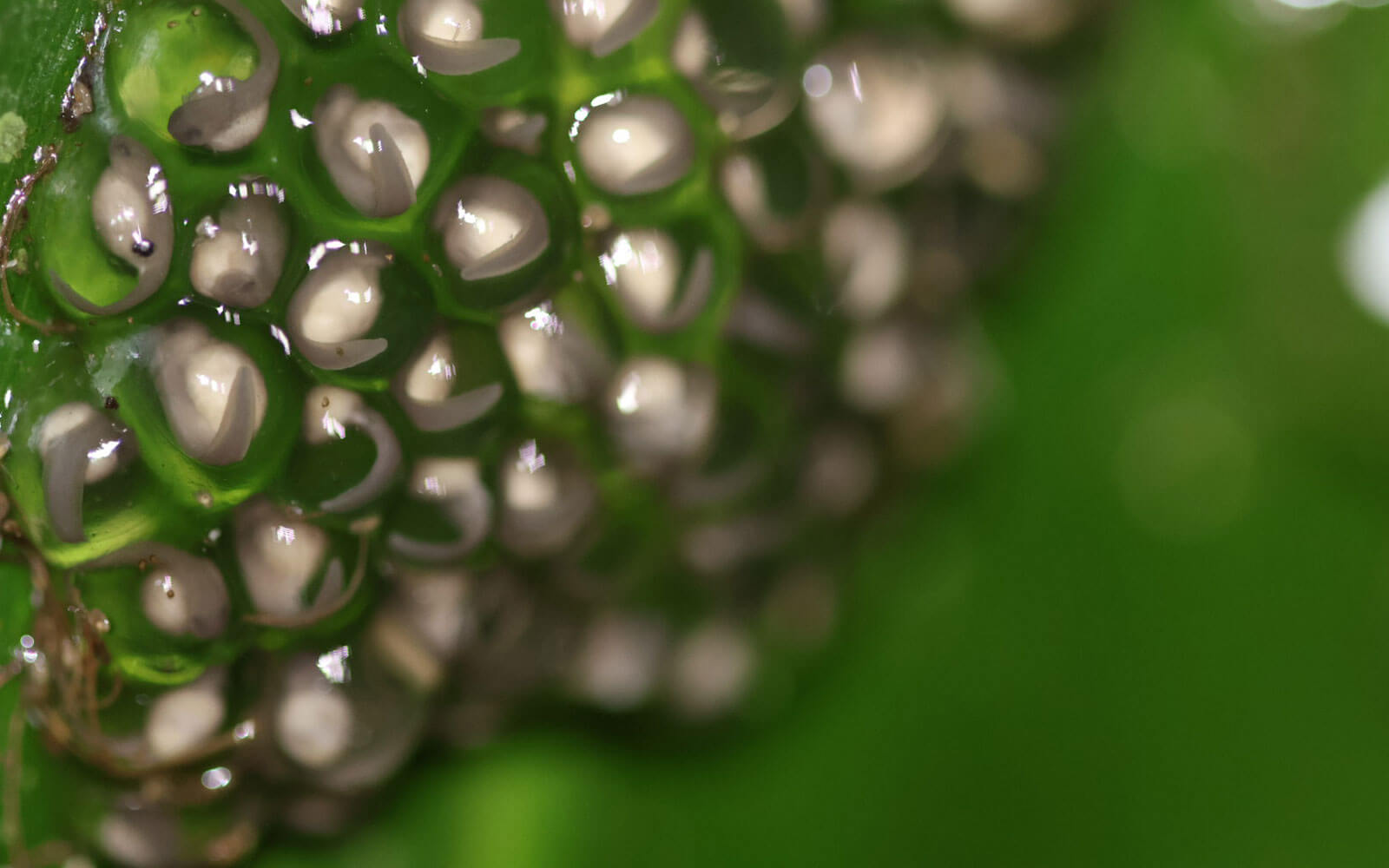
Kloof Frog tadpoles in eggs
As with all things ecological, life processes for frogs are complex, and reliant on multiple factors. While incredibly resistant to some change, and adaptable to extreme conditions, the case of the Kloof Frog provides a good example of the fragility of survival, and how the balance of ecosystems can be heavily impacted by layers of change. The population of Kloof frogs at Springside Nature Reserve act as the mascot for the Mend the Molweni Project, the goal of which is to reduce water quality issues in the Hillcrest area. Here the frogs face removal of vegetation, reduced water quality as a result of contaminants, sewage and sedimentation, and lack of sufficient shade cover. By managing these threats, the project aims to improve stream health, which will be reflected, hopefully, in improved breeding success of the Kloof Frog here, and as a pilot project for other urban streams, all of which benefit human health too.

About the author
Jeanne Tarrant, aka the “Frog Lady”, has worked in amphibian conservation and research for 18 years. Her passion for amphibians was ignited when she enrolled at North-West University in 2006 and went on to complete an MSc (2008, cum laude) and PhD (2012) through the African Amphibian Conservation Research Group. Thereafter, she conceptualised the Endangered Wildlife Trust’s Threatened Amphibian Programme (TAP) and ran successful projects across South Africa focused on the country’s threatened frog species for 12 years. In 2024 she embarked on a new amphibian-focused venture in the form of Anura Africa.
At Anura Africa, we aim to implement landscape-level amphibian conservation supported by scientific evidence and research. Anura Africa is committed to advancing amphibian conservation by identifying needs and knowledge gaps in South Africa and across the continent, bolstering research capacity through citizen science and partnerships with academic institutions, and implementing conservation actions informed by evidence. We strive to conserve and develop sustainable landscape-level habitat protection by implementing best practice natural resource management interventions aimed at ensuring the conservation of critical amphibian habitat. Our approach is guided by global amphibian conservation priorities, with a focus on enhancing ecosystem resilience and fostering species adaptation. Integral to our mission is supporting mindset shifts towards African amphibian conservation by improving awareness of the importance of amphibians, facilitating skills transfer, and strengthening local capacity. In her role as chair for the southern Africa regional working group for the IUCN’s Amphibian Specialist Group, Jeanne is well-placed to support these objectives.
In 2020, Jeanne was the recipient of the prestigious Whitley Award, or “Green Oscar” for her work in conservation, a career highlight with Sir David Attenborough narrating this short video. This award is given to grassroots conservationists from the global south – i.e., Africa, Asia and South America. Jeanne was one of 112 applicants, short-listed down to 6 winners, and the only recipient with a project focused on amphibians. Edward Whitley, founder of the Whitley Fund for Nature, said that Jeanne is an inspiring leader who tirelessly advocates for amphibians – an often-overlooked group. “We hope that this award will allow her to spread her important message far and wide and bring about real change for amphibians and their habitat through science, policy, and community education.” In 2024, Rolex recognised Jeanne’s work (one of 1500 applicants) through an exceptional small grant linked to the Rolex Awards for Enterprise, one of the pillars of the Rolex Perpetual Planet initiative, catalysing the launch of Anura Africa.
Anura Africa’s vision is to use research and conservation management to promote the resilience of ecosystems in multi-use landscapes. We advocate for amphibians as indicators of microhabitat health within larger conservation areas. By focusing on these indicators, Anura Africa aims to ensure the health of entire ecosystems, benefiting a wide range of species and ecological functions.
Instagram: anura_africa
Facebook: Anura Africa
LinkedIn: Anura Africa NPC